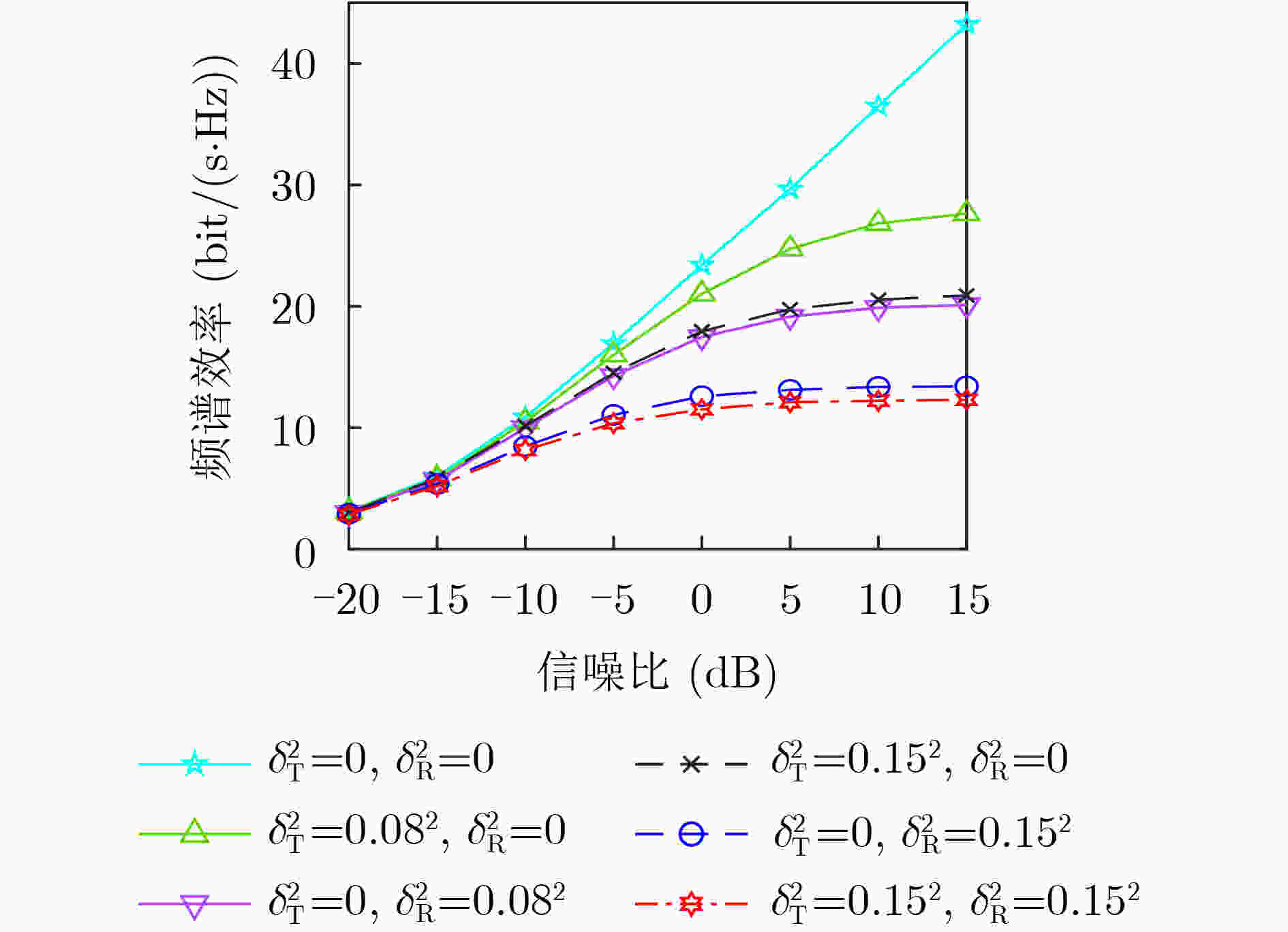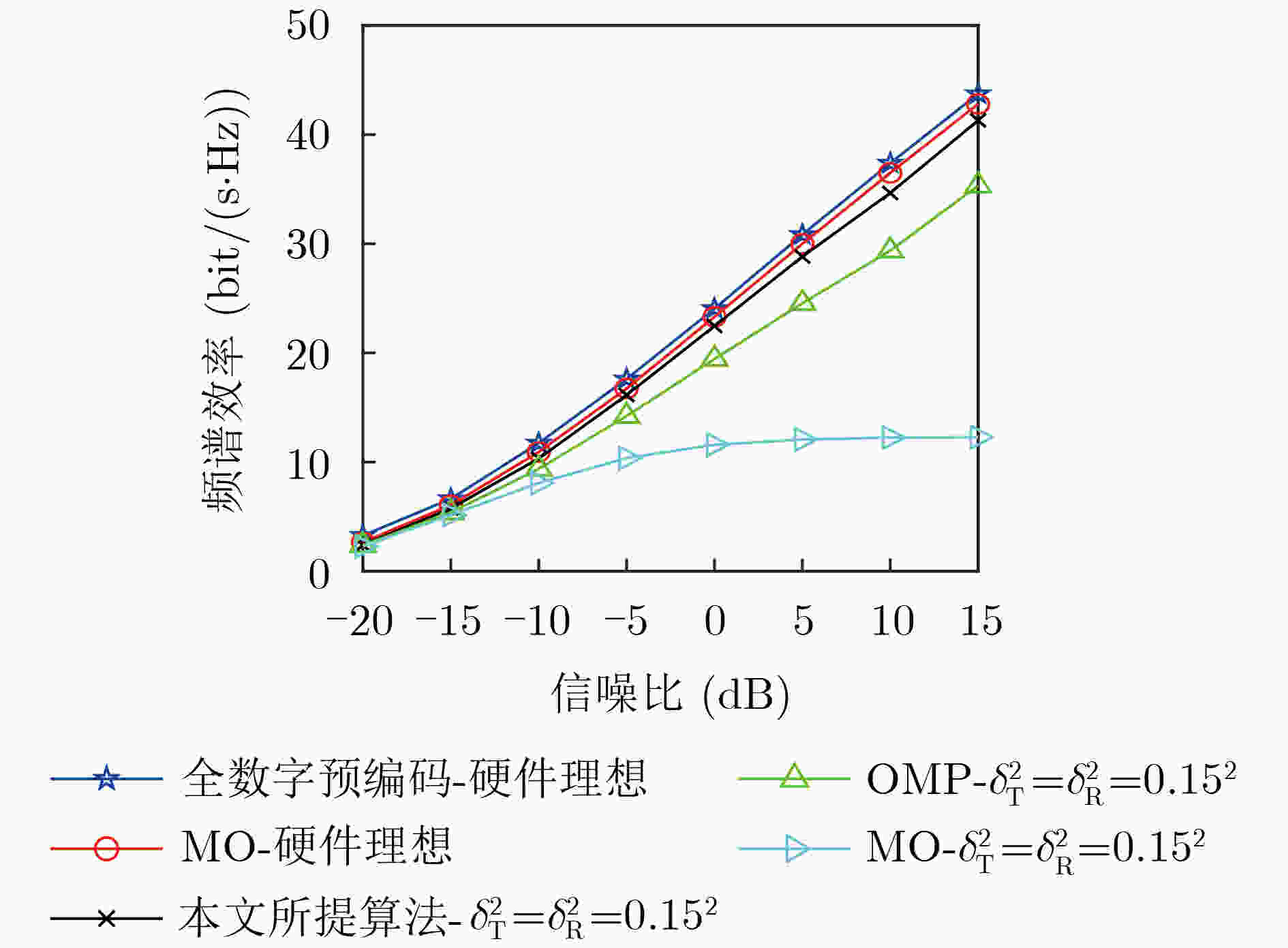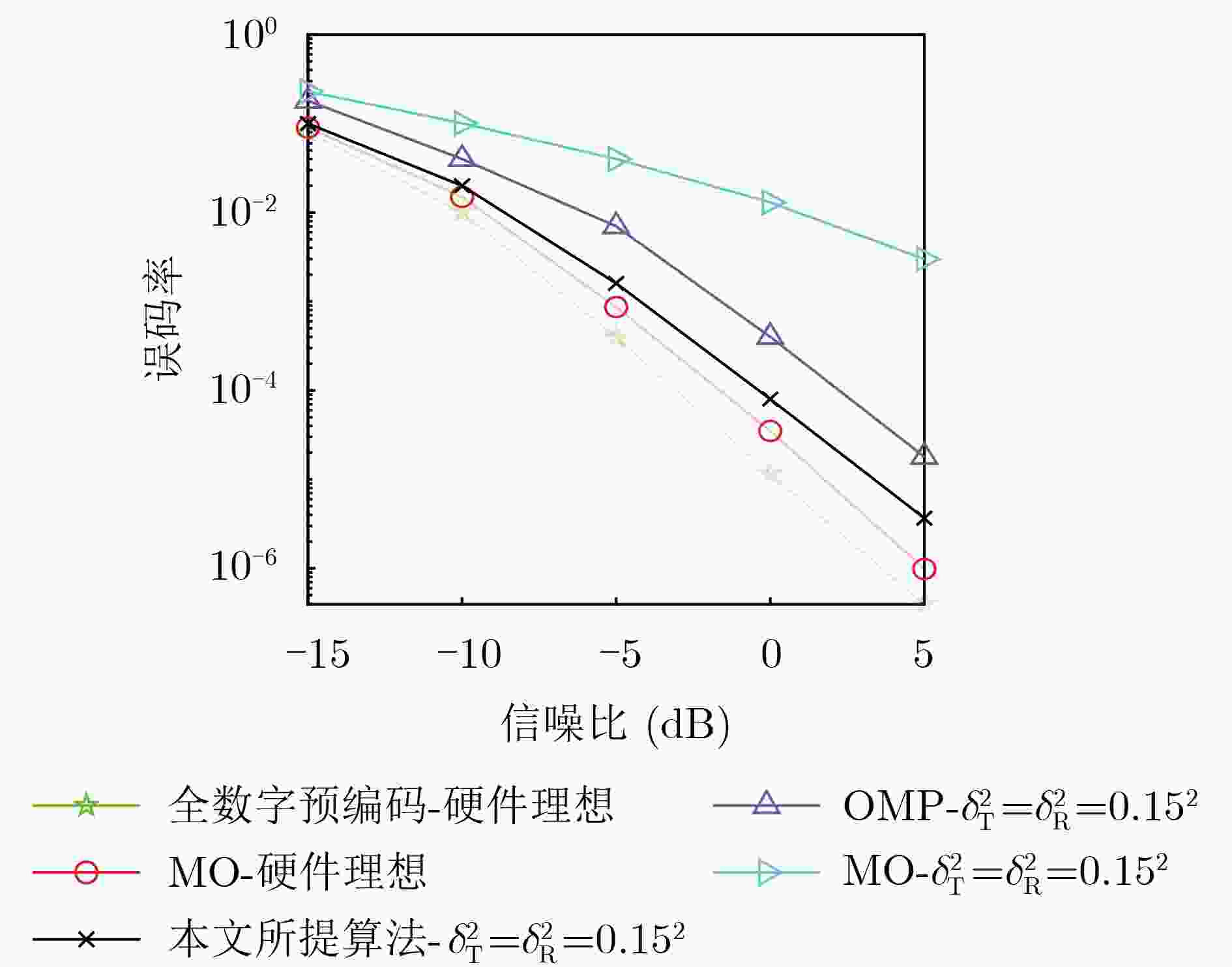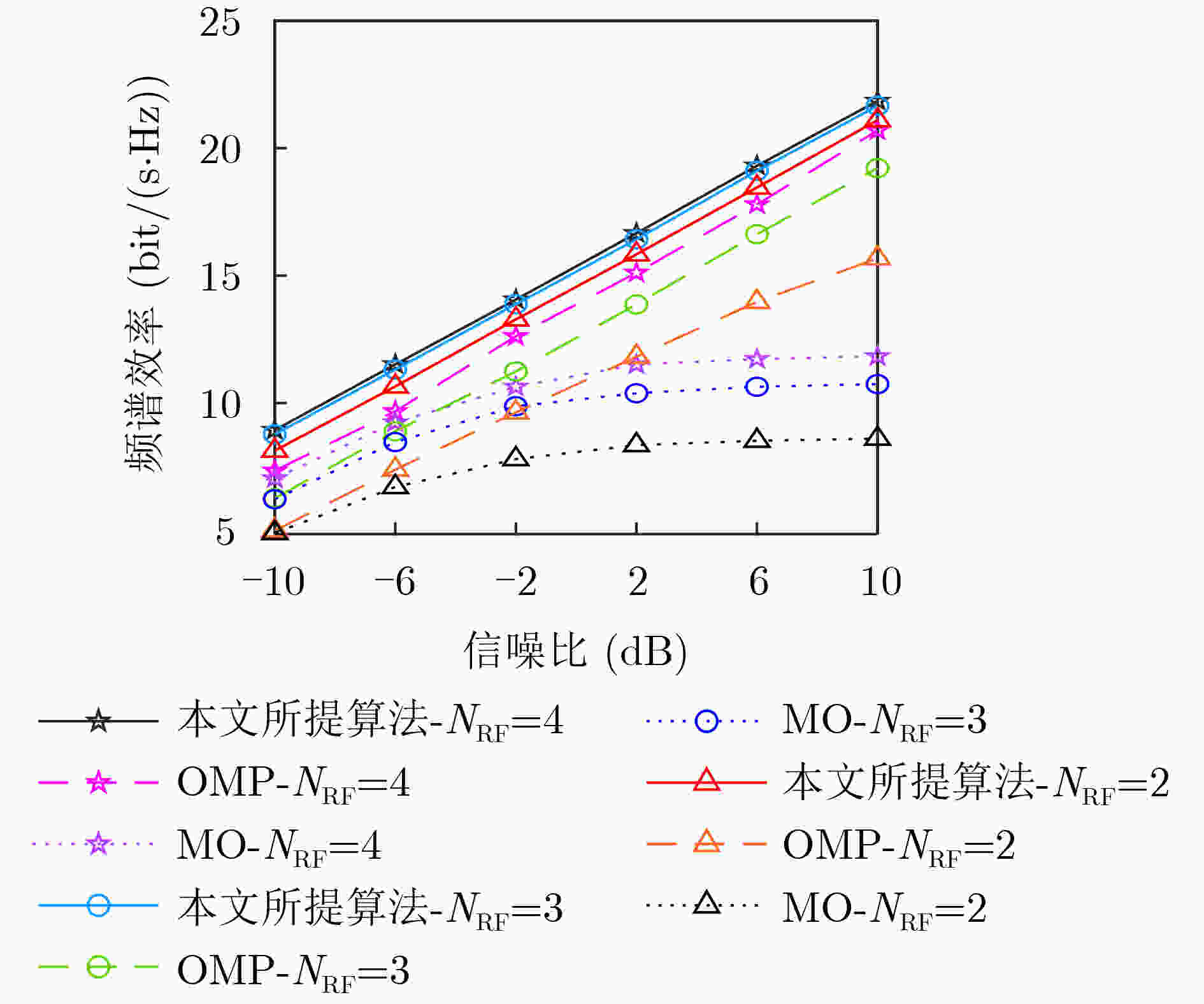A Hybrid Precoding Scheme for Millimeter Wave Massive MIMO System with Residual Hardware Impairments
-
摘要: 在假设通信收发机具有理想硬件特性的前提下,毫米波大规模多输入多输出(MIMO)系统的混合预编码问题已经获得了广泛的研究。然而,由通信收发机硬件非理想特性导致的残余硬件损伤在毫米波大规模MIMO系统中难以避免,并且会严重影响混合预编码的性能。针对这一问题,该文建立了在收发机残余硬件损伤影响下的毫米波大规模MIMO混合预编码模型,提出一种基于流形优化的混合预编码方案。首先根据收发信号之间的修正均方误差建立优化目标,进而推导出数字预编码矩阵与数字组合矩阵的闭合表达式,然后基于黎曼流形处理恒模约束问题获得模拟预编码矩阵与模拟组合矩阵,最后进行收发机交替迭代获得混合预编码的优化结果。仿真结果表明,该方案有效抑制了残余硬件损伤对毫米波大规模MIMO系统的不利影响,显著提升了系统的性能。Abstract: Based on the assumption of perfect transceiver hardware, the hybrid precoding of millimeter wave massive Multiple-Input Multiple-Output (MIMO) system has been extensively studied. However, the residual hardware impairments caused by non-ideal characteristics of transceivers are unavoidable in millimeter wave massive MIMO system, which lead to hybrid precoding performance degradation seriously. To address this problem, the hybrid precoding model which considers the impact of residual hardware impairments is built for millimeter wave massive MIMO system and a hybrid precoding scheme based on manifold optimization is proposed in this paper. Firstly, the optimization objective is designed with the modified mean square error. Then the closed-form expressions of the digital precoding and digital combining matrix are derived and the optimal solutions of the analog precoding matrix and the combining matrix are obtained by dealing with the constant modulus constraint on the Riemannian manifold. Finally, the joint hybrid precoding and combining design are achieved by iteratively and alternatively optimizing the hybrid precoding and the hybrid combining matrix. The simulation results show that the proposed scheme suppresses effectively the impact of residual hardware impairments on the millimeter-wave massive MIMO system, and improves significantly the system performance.
-
算法1 基于流形优化的抑制残余硬件损伤影响的混合预编码算法 输 入:信道矩阵$ H $,噪声功率$ {\sigma ^2} $,残余硬件损伤程度$ \delta _{\text{T}}^2 $和$ \delta _{\text{R}}^2 $,
混合组合矩阵${ {\boldsymbol{W} }_{{\rm{RF}}} }{ {\boldsymbol{W} }_{{\rm{BB}}} }$1 初始化${ {\boldsymbol{F} }_{{\rm{RF}},0} }$,确定初始搜索方向:${d_0} = - {\rm{grad} }\;f\left( { { {\boldsymbol{F} }_{{\rm{RF}},0} } } \right)$,
$ k = 0 $2 开始迭代 3 根据式(23)计算黎曼梯度:${g_k} = {\rm{grad} }\;f\left( { { {\boldsymbol{F} }_{{\rm{RF}},} }_k} \right)$ 4 计算切向量:$d_k^ + = {d_k} - \Re \left\{ { {d_k} \circ { {\boldsymbol{F} }_{{\rm{RF}},} }_k^*} \right\} \circ { {\boldsymbol{F} }_{{\rm{RF,}}} }_k$ 5 利用Polak-Ribiere共轭梯度法确定因子$ {\gamma _k} $ 6 更新迭代方向:$ {d_k} = - {g_k} + {\gamma _k}d_k^ + $ 7 采用Armijo回溯线搜索确定搜索步长$ {\alpha _k} $
8 回缩更新${F_{{\rm{RF}}} }$:${ {\boldsymbol{F} }_{{\rm{RF}},} }_k = {\rm{vec}}\left[ {\frac{ { { {\boldsymbol{F} }_{{\rm{RF,}}} }_k + {\alpha _k}{d_k} } }{ {\left| { { {\boldsymbol{F} }_{{\rm{RF}},} }_k + {\alpha _k}{d_k} } \right|} } } \right]$9 $ k \leftarrow k + 1 $ 10 重复步骤3~9直到满足条件停止迭代 11 根据式(17)得到${ {\boldsymbol{F} }_{\rm{U}}}$ 12 根据式(18)得到$ \beta $和数字预编码矩阵${ {\boldsymbol{F} }_{{\rm{BB}}} } = \beta { {\boldsymbol{F} }_{\rm{U}}}$ 输 出:${ {\boldsymbol{F} }_{{\rm{RF}}} },{ {\boldsymbol{F} }_{{\rm{BB}}} }$ 表 1 仿真参数
参数 值 毫米波频率(GHz)
发射功率(W)
发射/接收天线数
射频链数/数据流数
信道散射簇数目
每个簇的路径数60
1
128/12
4
5
10 -
[1] CHATAUT R and AKL R. Massive MIMO systems for 5G and beyond networks—overview, recent trends, challenges, and future research direction[J]. Sensors, 2020, 20(10): 2753. doi: 10.3390/s20102753 [2] KEBEDE T, WONDIE Y, STEINBRUNN J, et al. Precoding and beamforming techniques in mmWave-massive MIMO: Performance assessment[J]. IEEE Access, 2022, 10: 16365–16387. doi: 10.1109/access.2022.3149301 [3] DILLI R. Performance analysis of multi user massive MIMO hybrid beamforming systems at millimeter wave frequency bands[J]. Wireless Networks, 2021, 27(3): 1925–1939. doi: 10.1007/s11276-021-02546-w [4] HEGDE G, MASOUROS C, and PESAVENTO M. Interference exploitation-based hybrid precoding with robustness against phase errors[J]. IEEE Transactions on Wireless Communications, 2019, 18(7): 3683–3696. doi: 10.1109/twc.2019.2917064 [5] LIN Tian, CONG Jiaqi, ZHU Yu, et al. Hybrid beamforming for millimeter wave systems using the MMSE criterion[J]. IEEE Transactions on Communications, 2019, 67(5): 3693–3708. doi: 10.1109/tcomm.2019.2893632 [6] AYACH O E, RAJAGOPAL S, ABU-SURRA S, et al. Spatially sparse precoding in millimeter wave MIMO systems[J]. IEEE Transactions on Wireless Communications, 2014, 13(3): 1499–1513. doi: 10.1109/twc.2014.011714.130846 [7] SOHRABI F and YU Wei. Hybrid analog and digital beamforming for mmWave OFDM large-scale antenna arrays[J]. IEEE Journal on Selected Areas in Communications, 2017, 35(7): 1432–1443. doi: 10.1109/jsac.2017.2698958 [8] HAO Wanming, SUN Gangcan, ZENG Ming, et al. Robust design for intelligent reflecting surface-assisted MIMO-OFDMA terahertz IoT networks[J]. IEEE Internet of Things Journal, 2021, 8(16): 13052–13064. doi: 10.1109/jiot.2021.3064069 [9] XING Zhe, WANG Rui, WU Jun, et al. Achievable rate analysis and phase shift optimization on intelligent reflecting surface with hardware impairments[J]. IEEE Transactions on Wireless Communications, 2021, 20(9): 5514–5530. doi: 10.1109/twc.2021.3068225 [10] ZAREI S, GERSTACKER W H, AULIN J, et al. Multi-cell massive MIMO systems with hardware impairments: Uplink-downlink duality and downlink precoding[J]. IEEE Transactions on Wireless Communications, 2017, 16(8): 5115–5130. doi: 10.1109/twc.2017.2705709 [11] PAPAZAFEIROPOULOS A K, PAPAGEORGIOU G K, KOLAWOLE O Y, et al. Towards the assessment of realistic hybrid precoding in millimeter wave MIMO systems with hardware impairments[J]. IET Communications, 2021, 15(12): 1606–1619. doi: 10.1049/cmu2.12173 [12] PAPAZAFEIROPOULOS A, BJÖRNSON E, KOURTESSIS P, et al. Scalable cell-free massive MIMO systems: Impact of hardware impairments[J]. IEEE Transactions on Vehicular Technology, 2021, 70(10): 9701–9715. doi: 10.1109/tvt.2021.3109341 [13] ORTEGA A J. OMP-based hybrid precoding and SVD-based hybrid combiner design with partial CSI for massive MU-MIMO mmWave system[C]. 2020 International Conference on Communications, Signal Processing, and their Applications (ICCSPA), Sharjah, United Arab Emirates, 2021: 1–5. [14] PALOMAR D P, CIOFFI J M, and LAGUNAS M A. Joint Tx-Rx beamforming design for multicarrier MIMO channels: A unified framework for convex optimization[J]. IEEE Transactions on Signal Processing, 2003, 51(9): 2381–2401. doi: 10.1109/tsp.2003.815393 [15] JOHAM M, UTSCHICK W, and NOSSEK J A. Linear transmit processing in MIMO communications systems[J]. IEEE Transactions on signal Processing, 2005, 53(8): 2700–2712. doi: 10.1109/tsp.2005.850331 [16] LEE J M. Introduction to Smooth Manifolds[M]. 2nd ed. New York: Springer, 2012. [17] YU Xianghao, SHEN J C, ZHANG Jun, et al. Alternating minimization algorithms for hybrid precoding in millimeter wave MIMO systems[J]. IEEE Journal of Selected Topics in Signal Processing, 2016, 10(3): 485–500. doi: 10.1109/jstsp.2016.2523903 [18] HJORUNGNES A and PALOMAR D P. Patterned complex-valued matrix derivatives[C]. 2008 5th IEEE Sensor Array and Multichannel Signal Processing Workshop, Darmstadt, Germany, 2008: 293–297. -






 下载:
下载:







 下载:
下载:
